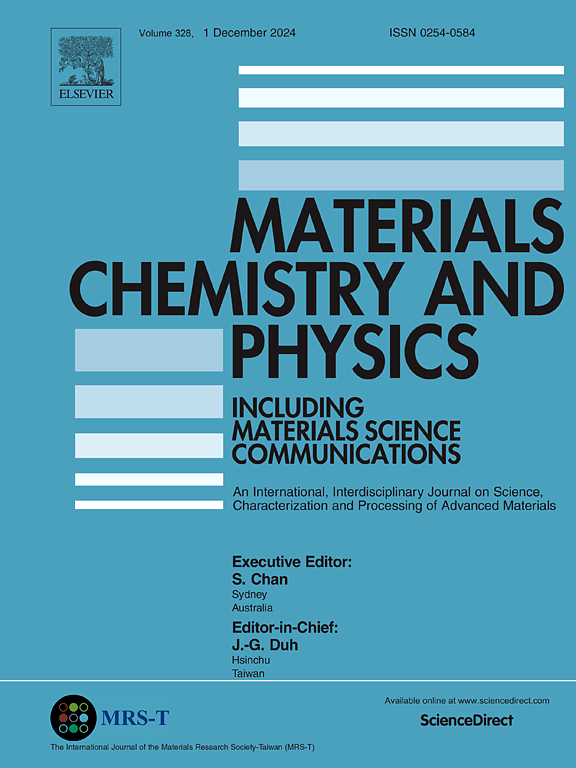作为超级电容器应用的高效电极的协同 Pd/MoO3-rGO 混合材料的合成与表征
IF 4.3
3区 材料科学
Q2 MATERIALS SCIENCE, MULTIDISCIPLINARY
引用次数: 0
摘要
本研究通过一锅水热法合成了 Pd-rGO 和 Pd/MoO3-rGO 纳米复合材料,可用作超级电容器的高效电极。研究采用了多种分析技术,包括 XRD、XPS、HRTEM、BET 和拉曼光谱,对纳米复合材料的结构、形态和理化性质进行了表征,以评估其电化学超级电容器性能。分析证实,Pd/MoO3-rGO 样品中 MoO3-NR 与 Pd-rGO 之间的电荷转移机制显著提高了 Pd/MoO3-rGO 的电化学性能,与 Pd-rGO 样品相比提高了 2.7 倍(0.5 A/g 时为 105.00 F/g)。值得注意的是,Pd/MoO3-rGO 混合材料表现出卓越的电化学活性,在 0.5 A/g 的电流密度下,比电容达到 291.50 F/g,能量密度和功率密度值分别为 18.06 Wh/kg 和 250.00 W/kg。此外,它在长期使用中表现出了显著的稳定性,在恒定电流密度为 1.0 A/g 的条件下,经过 1000 次循环后,其容量仍能保持 88.46%。这些发现凸显了 Pd/MoO3-rGO 纳米复合材料作为超级电容器高效电极材料的巨大潜力。本文章由计算机程序翻译,如有差异,请以英文原文为准。

Synthesis and characterization of synergetic Pd/MoO3–rGO hybrid material as efficient electrode for supercapacitor application
In this work, study synthesized Pd–rGO and Pd/MoO3–rGO nanocomposites via a one-pot hydrothermal method, serving as efficient electrodes for supercapacitor applications. Various analytical techniques, including XRD, XPS, HRTEM, BET, and Raman spectroscopy, were employed to characterize the structural, morphological, and physiochemical properties to assess the electrochemical supercapacitor performance of nanocomposite materials. The analyses confirmed that the charge transfer mechanism between the MoO3-NR with Pd-rGO in Pd/MoO3–rGO samples has significantly improved the electrochemical performance of Pd/MoO3–rGO by 2.7 times compared to Pd-rGO sample (105.00 F/g at 0.5 A/g). Remarkably, the Pd/MoO3–rGO hybrid material exhibited excellent electrochemical activity, boosting a specific capacitance of 291.50 F/g at a current density of 0.5 A/g, accompanied by energy density and power density values of 18.06 Wh/kg and 250.00 W/kg, respectively. Furthermore, it demonstrated noteworthy stability over prolonged usage, retaining 88.46 % of its capacity after 1000 cycles at a constant current density of 1.0 A/g. These findings underscore the promising potential of the Pd/MoO3–rGO nanocomposite as a highly effective electrode material for supercapacitors.
求助全文
通过发布文献求助,成功后即可免费获取论文全文。
去求助
来源期刊

Materials Chemistry and Physics
工程技术-材料科学:综合
CiteScore
8.70
自引率
4.30%
发文量
1515
审稿时长
69 days
期刊介绍:
Materials Chemistry and Physics is devoted to short communications, full-length research papers and feature articles on interrelationships among structure, properties, processing and performance of materials. The Editors welcome manuscripts on thin films, surface and interface science, materials degradation and reliability, metallurgy, semiconductors and optoelectronic materials, fine ceramics, magnetics, superconductors, specialty polymers, nano-materials and composite materials.
 求助内容:
求助内容: 应助结果提醒方式:
应助结果提醒方式:


